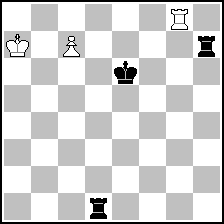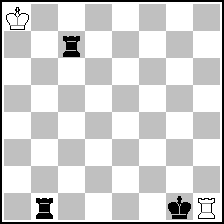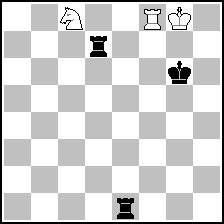
Website founded by
Milan Velimirović
in 2006
18:10 UTC


| |
MatPlus.Net  Forum Forum  Competitions Competitions  Christmas schism Christmas schism |
| |
|
|
|
|
You can only view this page!
| | | (1) Posted by Marcos Roland [Thursday, Dec 23, 2021 15:06] | Christmas schism
This study was submitted to the participants of the "Brazilian Christmas Solving Contest 2021", held in Belgrade and Riga, last Saturday:
Sebastião A. da Silva
Shakhmaty (Riga), 1971 - 1st/2nd Prize
Draw
 (= 3+3 ) (= 3+3 )
The composition sparked a very lively debate, even heated at certain times, between the participants and the organizers of the event. I would summarize the points in discussion in this way:
i) can we stablish that the solution of the study features a clear "main line"?
ii) if so, which is the main line?;
iii) if there is no clear main line, does it mean that there are several equivalent lines to reach the same final position?
iv) in that case, we should conclude that the study is not suitable for solving rated competitions?
v) BTW, which is to be considered the "final position" of the study?
vi) is the lenght of the line (number the moves until reaching the final position) an infalible criterium to determine which is the main line?
vii) how should the points be distributed to the participants accordingly to what they wrote in the solving sheet?
Clearly, White must start pushing his pawn: 1.c7. Now, Black should choose between 1...Ke6 and 1...Kf6. He could consider 1...Kd6, intending to answer to 2.Td8+ with Td7, but then White reaches immediately a clear drawn position with 3.Kb8! Tc1 3.c8=D. On the other hand, checking immediately the WK only helps White: 1...Ta1+ 2.Kb8 Tb1+ 3.Ka8 draw.
So, the candidate first Black moves are 1...Ke6 and 1...Kf6. Let's see first 1...Ke6:
 (= 3+3 ) (= 3+3 )
(to be continued)
| | | (2) Posted by Marcos Roland [Thursday, Dec 23, 2021 15:31] |
We must immediately note that 2.Kb8? would be premature. It follows 2...Tb1+ 3.Ka8 Txc7, and we reach this position:
 (= 2+3 ) (= 2+3 )
Black wins, because he will escape from white checks by reaching the "b" column and then unstalemating WK, for example:
4.Tg6+ Kd5 5.Tg5+ Kc4 6.Tg4+ Kb5 7.Tg5+ Tc5 +-
We are ready to draw the first conclusion for understanding the study: in general, after the BR takes on c7, potencially stalemating the WK, if the WR is on the right side of the BK, Black wins like above.
So, let's see what happens in the opposite situation, i.e., the WR is on the left side of the BK. After 1...Ke6, White first checks the BK, and then plays Kb8:
1...Ke6 2.Te8+ Kf6 (2...Kf5 doesn't help either) 3.Kb8! Ta1+ 4.Ka8 Txc7, reaching this position:
 (= 2+3 ) (= 2+3 )
Now White draws by perpetual check or stalemate: 5.Te6+ Kf5 6.Te5+, etc., eventually reaching a stalemate finish by checking the BK on h1:
 (= 2+3 ) (= 2+3 )
(to be continued)
| | | (3) Posted by Marcos Roland [Tuesday, Dec 28, 2021 00:58] |
So, generally speaking, if the WR is on the left side of the BK, White can make a draw. But there are exceptions. First exception takes place when BK reaches the first rank, like this position, which can happen after 1.c7 Kf6 2.Tf8+ Kg6 3.Tg8+ Kf5 4.Tf8+ Ke4 5.Te8+ Kf3 6.Tf8+? (6.Kb8! =) Ke2! 7.Te8+ Kf1!, when Black wins:
 (= 3+3 ) (= 3+3 )
In this position, even if White gives a few more checks (8.Tf8+ Kg1 9.Tg8+ Kh1), Black wins after 10.Kb8 Tb1+ 11.Ka8 Txc7, because White cannot start checking the BK with 12.Tg1+? Txg1!, and if White plays 12.Th8+, Black replies 12...Kg2!, and wins because the WR took the right side of the BK.
As we see, the best chance for Black is to try to reach the first rank, when escaping from the checks. And this try only has importance in this study because of a tactical exception we'll see now. Based on the above, we can state that the best first move for Black, the one which creates more problems for White is 1...Kf6!. Now White has to check: 2.Tf8+, and if 2...Ke6 (Ke5), he draws with 3.Te8+, etc., as we have seen above. But now comes the tactical exception which gives the "reason of being" to this study: 2...Kg5!, reaching this position:
 (= 3+3 ) (= 3+3 )
One might think that, given that the WR is on the left side of the BK, White can safely draw with 3.Kb8 Tb1+ 4.Ka8 Txc7 5.Tf5+, etc. However, instead of 4...Txc7, Black plays the surprising 4...Th2!!, see:
 (= 3+3 ) (= 3+3 )
Now, White has two ways of losing:
a) 5.Tf5+ Kg6! 6.Ta5 Tc2 7.Ta7 Kf6 8.Tb7 Tbc1, etc.
b) 5.c8=S Ta1+! 6.Kb7 Tb2+ 7.Kc7 (7.Sb6 Tab1) Tc1+ 8.Kd7 Td2+ 9.Ke7 Te1+ 10.Kf7 Td7+ 11.Kg8 Kg6!, and mate is coming:
 (= 3+3 ) (= 3+3 )
(to be continued)
| | | (4) Posted by Alain Villeneuve [Tuesday, Dec 28, 2021 15:13] |
Boa tarde Marcos,
Thank you for explaining in a clear way this excellent study.
I discovered it is in the album 1971-73 and saw some inaccuracies in the VdH database, but I will let you finish your presentation.
Of course you guess my opinion about your question 4 : it is inappropriate for a solving contest, like hundreds of fascinating studies !
| | | (5) Posted by Marcos Roland [Tuesday, Dec 28, 2021 18:21] |
Thank you, Alain! I'll finish tonight.
| | | (6) Posted by Marcos Roland [Wednesday, Dec 29, 2021 01:20] |
So the trickiest line, the one which puts more problems for White is 1.c7 Kf6 2.Tf8+ Kg5!:
 (= 3+3 ) (= 3+3 )
Now White cannot play immediately 3.Kb8?, as we have seen. Then 3.Tg8+! is mandatory, and the best try for Black is 3...Kf4!, when once more the WR is on the right side of the BK, so White must go on checking, and play follows in this way: 4.Tf8+! Ke3! (black aims to reach the first rank) 5.Te8+!, and now, unfortunately for Black, he cannot play 5...Kd2? So, he must play 5...Kf2, reaching this position:
 (= 3+3 ) (= 3+3 )
Now, and only now, White can and must play 6.Kb8! (6.Tf8+? Kg1, and Black wins) Tb1+ 7.Ka8 Txc7 8.Te2+ =. A possible finish is 8...Kf1 9.Tf2+ Kg1 10.Tg2+ Kh1 11.Th2+ Kg1 11.Th1+ Kxh1 stalemate.
A remarkable feature of this fine study is that it needs all the columns and ranks of the board to make sense. To illustrate this point, see, if the Td1 were on d2 in the last diagram:
 (= 3+3 ) (= 3+3 )
...Black would win.
To recap, the main line of the study, in the way I understand it, is 1.c7 Kf6 2.Tf8+ Kg5! (this is trickier than the also plausible 2...Kg6 3.Tg8+ Kf5!, etc.) 3.Tg8+ Kf4 4.Tf8+ Ke3 5.Te8+ Kf2 6.Kb8 Tb1+ 7.Ka8 Txc7 8.Te2+ =.
As for the questions I mentioned when beginning this thread, I would like to hear the opinion of anyone who would like to take the floor. Alain has advanced that he thinks the study is not suitable for solving contests. I agree with him (and apologize to the participants of the event...), but I wonder if our reasons are the same.
| | | (7) Posted by Alain Villeneuve [Wednesday, Dec 29, 2021 23:31] |
Dear Marcos,
I agreed with your analysis. If 6 Rf8+? Kg1!, you say that Black wins, I just want to add this 7 Rg8+ Kh1! 8 Kb8 Rb1+! 9 Ka8 Rxc7! (not ...Rh2? given in the VdH base, because 10 c8N!!) 10 Rh8+ Kg2! 11 Rh2+ Kf3! -+ illustrating what you said about the Rook on the (good) left side of the Black King and... the (wrong) right side.
Hope this delicious study will be appreciated... outside a solving competition !
| | | (8) Posted by Alain Villeneuve [Wednesday, Dec 29, 2021 23:33] |
Deleted
| | | (9) Posted by Alain Villeneuve [Wednesday, Dec 29, 2021 23:33] |
Deleted
| | | (10) Posted by James Malcom [Thursday, Dec 30, 2021 00:04] |
Deleted
| | | (11) Posted by Alain Villeneuve [Thursday, Dec 30, 2021 22:22] |
Deleted
| | | (12) Posted by Alain Villeneuve [Saturday, Jan 1, 2022 21:29] |
Dear Marcos,
I want to apologize for my mistakes, due to the fact that I am a very bad typist ! This may have frightened people who wanted to intervene.
Once again, I want to differentiate good studies and studies... good for solving tournaments, a whole other thing. For instance, I composed many studies, but only 3 or 4 could be selected for solving contests. One of my favorites composers, Artur Mandler, has no more in proportion !
Since 1995 (Turku), I participate in many solving championships. I always have difficulties with studies : I disagree with the schedule, with writing of solutions, etc. To extent that I suggested this : studies should be excluded from solving contests. I talked to many distinguished problemists, they agreed with me.
Seems paradoxical, because everybody knows I am "madly in love" with studies !
Let me finish by answering your questions :
1) Yes, but it is very hard to solve. It is essential that there is a clear main line in every study given in a solving contest.
2) You gave it and I agree. My only regret is that there is no Knight promotion in it : only in the tries !
3) Seems now irrelevant.
4) Already answered, but for other reasons.
5) After 11 Rh2+!.
6) No, I think it is the maximum beauty & accuracy.
7) Regarding the discussions I had with arbiters since 25 years, I need a long explication, with a bottle of cachaça !
Happy new year. Deus vos custodiat.
| | | (13) Posted by Hauke Reddmann [Sunday, Jan 2, 2022 09:11] |
@Alain: Methings excluding any study is too harsh.
There are very short studies where you must only
see one tactical brilliant move.
| | | (14) Posted by Marcos Roland [Sunday, Jan 2, 2022 21:23] |
Alain, thank you very much for your comments, and your typos are irrelevant, don't worry!
Now, about the answers, I think maybe we agree that the study is not suitable for solving contests, above all because it is very hard to solve, is that right? I hesitated before selecting it, because I had doubts about its level of difficulty. I knew that I would never manage to solve it in a solving contest, but I am not a strong solver. I really didn't know if strong solvers, some of them grandmasters, would manage to understand its nuances in so little time. Now I think they have touched the main idea, the antinomy right side/left side of the BK, but their answers didn't demonstrate to me that they had coped with the "exceptions" I mentioned.
I wonder what would happen if this study had been submitted in a WCSC type tournament, with one section dedicated only to studies, with 100 minutes for the three studies. That would be different, maybe someone in Belgrade would have at least gone farther in the solution. I think the more critical moment is to realize that Black can play 3.Kg5! after 2.Tf8+, so that he can dream of reaching the first rank with his King.
I agree with you, the final position of the study takes place after 12.Th1+! However, this implies a curious situation, as a very strong solver in Belgrade has pointed out. You see, in the solution I gave, I discarded the Black's first move 1...Ke6 with these words: "1...Ke6? 2.Te8+ draws more quickly". Is that correct? See the sequence: 1.c7 Ke6 2.Te8+ Kf5 3.Kb8 Tb1+ 4.Ka8 Txc7 5.Te5+ Kf4 6.Te4+ Kf3 7.Te3+ Kf2 8.Te2+ Kf1 9.Tf2+ Kg1 10.Tg2+ Kh1 11.Th2+ Kg1 12.Th1+! We see that the lenght of the sideline 1...Ke6 is precisely the same of the main line! Very curious! So, in this sense, White doesn't draw more quickly after 1...Ke6, maybe I should have written "draws more easily"!? Incidentally, the reason behind my question about lenght becomes apparent.
(to be finished)
| | | (15) Posted by Marcos Roland [Sunday, Jan 2, 2022 21:53] |
There is at least another interesting point in this study. As I have said, after 1.c7 Kf6 2.Tf8+, besides 2...Kg5, also 2...Kg6 is plausible, with the idea to answer 3.Tg8+ with 3...Kf5! (not 3...Kh6, when 4.Kb8! draws "more easily"). Now play continues 4.Tf8+ Ke4! 5.Te8+ Kf3 6.Kb8!, etc. The interesting point I mentioned is what happens if White wrongly plays 6.Tf8+?, and play goes: 6...Ke2! 7.Kb8 Tb1+ 8.Ka8 Txc7 9.Tf2+, reaching this position:
 (= 2+3 ) (= 2+3 )
Now Black must still be careful. He cannot rush to reach the "b" column with 9...Kd3?, when White has a draw after 10.Td2+ Kc4? 11.Tc2+. Instead Black must choose the "quiet" 9...Ke3!, gaining time to protect the Tc7 after 10.Te2+ Kd4! 11.Td2+ Kc5 12.Tc2+ Kb6.
We came to the conclusion that the line 2...Kg6 can also be interestingly tricky.
In the end of the day, although I still think that 2...Kg5 is the main line, even because it's more "logical" (after all, this can be called a "logical" study), I cannot say that it is a totally clear "main line". If we think abouth lenght, others can be "equivalent"; if we think about tricks and traps, 2...Kg6 is also attractive.
To end up, although we can have several possible reasons for not using this study in solving contests, I hope nobody will deny that it's a fine work of art!
| | | (16) Posted by Alain Villeneuve [Sunday, Jan 2, 2022 23:58] |
 (= 6+6 ) (= 6+6 )
This is a study from Kasparian. More later !
| | | (17) Posted by Alain Villeneuve [Monday, Jan 3, 2022 00:16] |
It was given in the last French solving championship where I participated, in 2009. The main line is
1.Rd8+! Kxe4 2.Bd5+ Kf4 3.Rf8+ 4.c7 Kh5 5.c8Q Ng4+ 6.Qxg4+!! Rxg4 7.Rf5+ R6g5 (R4g5 8 Bf3#] 8.Bf7#
But why 2...Kf4, only because there is a dual after 2...Kf5 : you can also play 3 Nxe5.
It does not matter about the value of the study, but can you be sure there is a "clear main line" for a solving contest ?
More tomorrow !
| | | (18) Posted by Alain Villeneuve [Monday, Jan 3, 2022 11:11] |
Marcos, the question of your 1...Ke6 variation is not that "it draws more quickly" but the dual after 2 Re8+! Kf5 (the same with Kf6) 3 Rf8+! (instead of 3 Kb8!). It cannot be the main line.
About your other remark, you don't need to deviate with 2...Kg6 or 3...Kf5 to have it, in the author's main line, you have the try 6 Rf8+?. Black plays 6...Kg1! but he can play also 6...Ke2?! (only a waste of time) 7 Re8+ Kf1! 8 Rf8+ Kg1!.
But if the BK is on f3 instead of f2, he cannot go to g1 but must go to e2. So, you don't need 2...Kg6 to have your try, you may play simply 5...Kf3 6 Rf8+? (6 Kb8!).
By the way, it is possible to extend the author's main line by 5...Kf3 6 Kb8! Rb1+ 7 Ka8 Rxc7 8 Re3+ Kf2 9 Re2+ : we are at the 9th move instead of 8th !
Yes, a fine work of art !
| | | (19) Posted by Alain Villeneuve [Monday, Jan 3, 2022 11:19] |
Yes Marcos, there are many precious stones in the tries.
I am working at the moment on a fantastic study with R+P/R+P (Frolovski & Zhuravliev 2003) that I prepare for a future course (see "le cours du maître" ; click EN for the english version). The solution in VdH base is very incomplete. In the tries (not given), there is enough to compose... another study, maybe two or three ! All this has, of course, nothing to do with a solving contest !
Let me finish with this quote of John Beasley, who was redactor of the fine "BESN", so as passionate (more ?) than me about studies.
"I am in favour of solving studies for fun, but for serious competitions, where competitors will discuss every detail, the accuracy of 'mate in n moves' is essential. That is why the chess problem was invented!".
| |
No more posts |
MatPlus.Net  Forum Forum  Competitions Competitions  Christmas schism Christmas schism |
|
|
|
 ISC 2024
ISC 2024 Forum
Forum  Competitions
Competitions  Christmas schism
Christmas schism 


